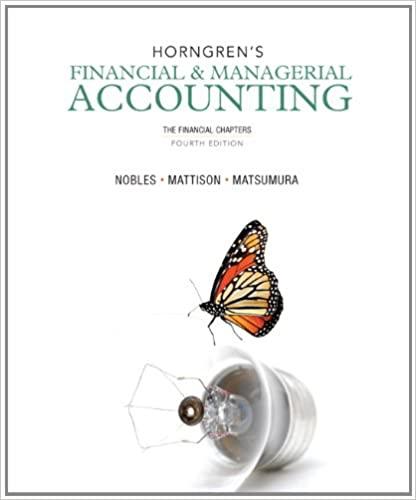Question
Question 1 (1 point) If a company sells one unit above its break-even sales volume, then its operating income would be equal to Question 1
Question 1 (1 point)
If a company sells one unit above its break-even sales volume, then its operating income would be equal to
Question 1 options:
the fixed expenses. | |
zero. | |
the unit contribution margin. | |
the unit selling price. |
Question 2 (1 point)
A shift in the sales mix from a product with a high contribution margin ratio toward a product with a low contribution margin ratio will cause the break-even point to
Question 2 options:
increase. | |
increase or decrease, but the direction of change cannot be determined from the information given. | |
decrease. | |
remain the same. |
Question 3 (1 point)
How do we calculate the unit sales volume necessary to reach a target profit?
Question 3 options:
Target profit unit contribution margin | |
(Fixed expenses + target profit) contribution margin ratio | |
Target profit contribution margin ratio | |
(Fixed expenses + target profit) unit contribution margin |
Question 4 (1 point)
What is the margin of safety?
Question 4 options:
The sales level at which operating income is zero | |
The amount of fixed and variable costs that make up a company's total costs | |
The excess of expected sales over break-even sales | |
The difference between the sales price per unit and the variable cost per unit |
Question 5 (1 point)
Target profit analysis is used to calculate the sales volume that is needed to
Question 5 options:
cover all fixed expenses. | |
earn a specific amount of net operating income. | |
cover all expenses. | |
avoid a loss. |
Question 6 (1 point)
When a company is operating at its break-even point
Question 6 options:
its contribution margin is equal to its variable expenses. | |
its fixed expenses are equal to its variable expenses. | |
its total revenues are equal to its total expenses. | |
its selling price is equal to its variable expense per unit. |
Question 7 (1 point)
If the operating leverage factor is 3, then a 2% change in the number of units sold should result in a 6% change in
Question 7 options:
variable expense. | |
operating income. | |
sales. | |
unit contribution margin. |
Question 8 (1 point)
If the sales price of a product increases while everything else remains the same, what happens to the break-even point?
Question 8 options:
The break-even point increases. | |
The break-even point decreases. | |
The break-even point remains the same. | |
The effect cannot be determined without further information. |
Question 9 (1 point)
The number of units to be sold to reach a certain target profit is calculated as
Question 9 options:
Target profit contribution margin ratio. | |
Target profit unit contributionmargin. | |
(Fixed expenses + target profit) unit contribution margin. | |
(Fixed expenses + target profit) contribution margin ratio. |
Question 10 (1 point)
The break-even point on a CVP graph is
Question 10 options:
the intersection of the sales revenue line and they-axis. | |
the intersection of the sales revenue line and the total expense line. | |
the intersection of the fixed expense line and the total expense line. | |
the intersection of the fixed expense line and the sales revenue. |
Step by Step Solution
There are 3 Steps involved in it
Step: 1

Get Instant Access to Expert-Tailored Solutions
See step-by-step solutions with expert insights and AI powered tools for academic success
Step: 2

Step: 3

Ace Your Homework with AI
Get the answers you need in no time with our AI-driven, step-by-step assistance
Get Started


